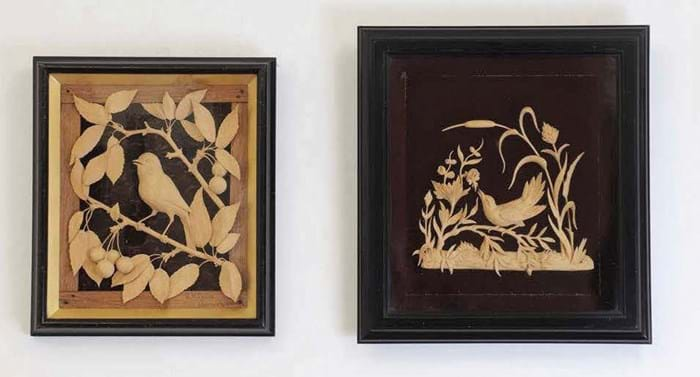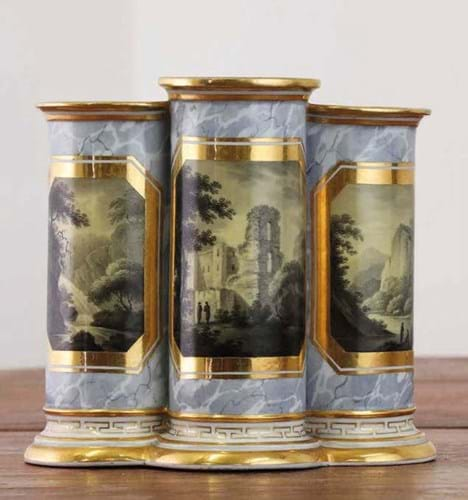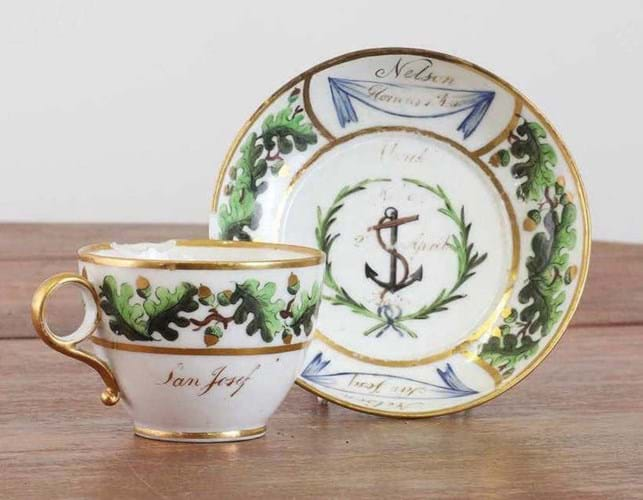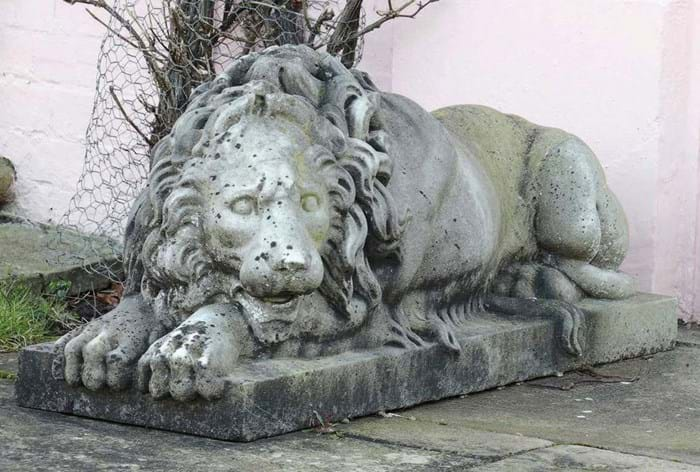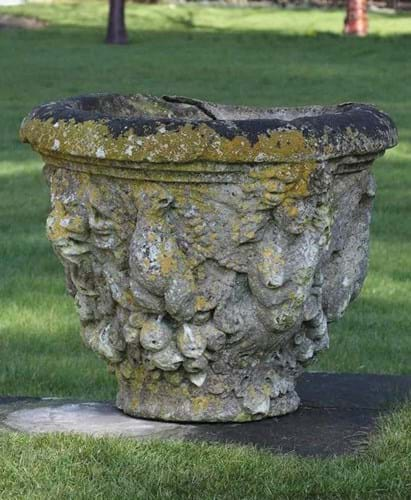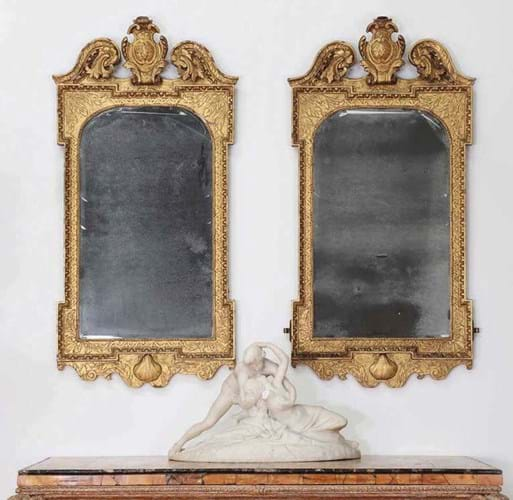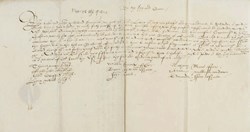Sworders’ (25% buyer’s premium) Fine Interiors sale included items from Bixley Manor, near Norwich – home to one of East Anglia’s best-known families.
Ninety lots of traditional art and antiques from the estate of businessman Sir Timothy James Alan Colman (1929-2021) and his wife Lady Mary Colman (née Bowes-Lyon), niece of the Queen Mother, sold for a hammer total of £160,000 on June 14-15.
The great-grandson of Jeremiah James Colman (1830-98), the man who turned Colman’s Mustard into an international brand, Sir Timothy began his career on the shop floor of the Carrow Works in Norwich.
However, in 1957 he became a director of Eastern Counties Newspapers – a company his ancestor Jeremiah Colman (1777-1851) had co-founded in 1844 – and was chairman of the group from 1969-96.
Family silver
The family silver collection was particularly good: a substantial array of good-quality tablewares including eight pairs of Georgian and Georgian style candlesticks.
The best of these were two pairs of London-made Britannia standard table sticks made to a textbook baluster form and gadrooned model that was popular for two decades. They sat reasonably well as a ‘four’ but were by different makers and dates.
A pair made by Joseph Bird, 1697 during the reign of William III, each engraved underneath the rim with the initials IH over MG, sold at £8500, while a Queen Anne pair by Anthony Nelme, 1709, made £9200. The buyers were all members of the London trade.
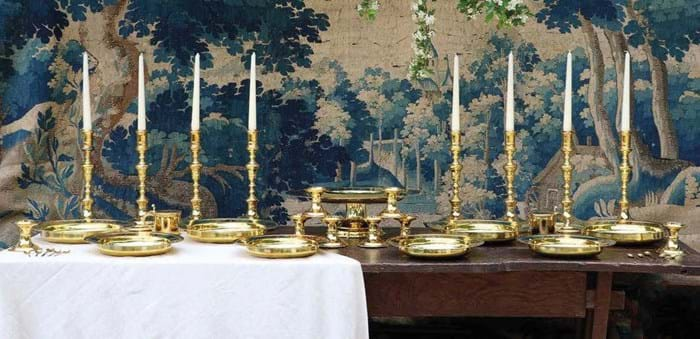
An ‘Armada’ pattern silver-gilt presentation service by Walter H Willson made to mark the golden wedding anniversary of Russell James Colman – £10,000 at Sworders.
Leading the Colman consignment was an ‘Armada’ pattern silver-gilt presentation service by Walter H Willson, London 1937.
Made in the Elizabethan style, it is engraved to the underside of the tray with the details of its commission. It reads: This service, comprising nine dishes, eight candlesticks, eight salts and two mustard pots, was presented to Russell James Colman Esquire and Mrs Colman on the occasion of their Golden Wedding, 20th June 1938 by their friends and admirers in the County of Norfolk and the City of Norwich.
Russell James Colman (1861-1946) was the eldest surviving son of Jeremiah James Colman. He is best known today for the remarkable collection of Norwich School paintings, watercolours and drawings he bequeathed to the Castle Museum.
The service is perhaps not the most commercial of objects, but it gains much as a set and does weigh in at a hefty 533oz. It took its mid estimate of £10,000 from a London dealer bidding online.
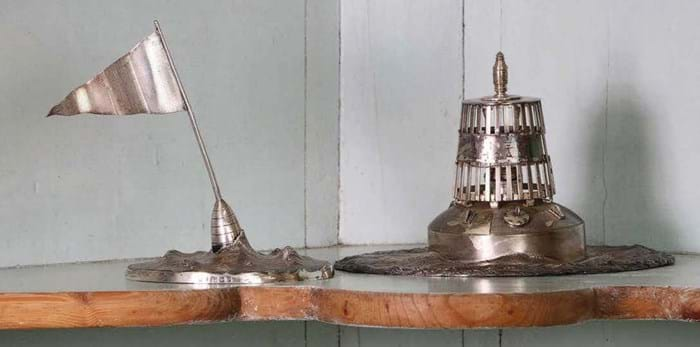
Two silver sailing presentation trophies marked for Theodore Ross of Market Place, Norwich – £1700 at Sworders.
Sir Timothy Colman was a skilled yachtsman and claimed the record for the world’s fastest yacht on several occasions (in 1980 his catamaran Crossbow II sailed at 36 knots).
This maritime prowess was reflected in two silver sailing presentation trophies marked for Theodore Ross of Market Place, Norwich, and hallmarked for London 1930. One is modelled as The Bell Buoy, Great Yarmouth and engraved with a line from the Kipling poem The Bell Buoy: - I dip and I surge and I swing In the rip of the racing tide – with the other cast as a pennant buoy. Offered together the lot made £1700.
Craftsmen encouraged
The Colman family were well-known collectors of East Anglian works of art and patrons of local craftsmen.
The Norfolk sculptor and woodcarver James W Minns (c.1828-1904) was engaged to complete the Jacobean-style staircase, panelling and chimneypieces at Carrow House, Norwich. This was the Colman family home until the 1880s, when the house became offices for the mustard works.
Minns has also been credited with designing the original bull’s head emblem that is still used by Colman’s Mustard today.
The sale included two examples of his considerable skill with a mallet and chisel.
A framed liewood relief carving of a robin perched on a cherry branch, signed and dated JW Minns Norwich, 1888 was offered with another similar unsigned example. Estimated at £400-600, the pair attracted spirited bidding and eventually sold to an online buyer at £2200.
Bixley ceramics
The most eagerly contested of Bixley’s ceramics was a Worcester Flight Barr & Barr trio vase that took £3000 (estimate £300-500).
Painted (probably by John Pennington) with three sepia vignettes of ruined buildings in landscapes against a marble ground, it is impressed and inscribed underneath with the Coventry Street address of the firm’s London office. It was in fine condition with only slight loss to the gilding.
Made perhaps a decade earlier, c.1802, was a Paris porcelain cup and saucer from Nelson’s ‘Baltic service’.
Painted with oak leaf reserves, it carries several gilt inscriptions reading 15th Febry, San Joseph and Glorious 1st August (to the cup) and Nelson San Joseph and Nelson Aboukir (to the saucer).
The Baltic set was part of a presentation of chinaware given to Nelson in 1802 by the Ladies of the City of London. Completed in some haste by a London decorating workshop, it was made using both Paris and Coalport porcelain blanks.
A teaset was delivered to Merton, the house Nelson shared with Emma Hamilton, and is listed there in an 1805 inventory, but other family members are known to have owned elements of the service.
By descent from Nelson’s niece Charlotte Nelson, Duchess of Bronte, the Lord Bridport sale at Christie’s in July 1895 featured many pieces, of which this cup and saucer were probably one. Accompanied by a receipt of purchase from Mortlock’s Ltd dated August 1895, it was hampered by condition (rim chips to both cup and saucer) but sold at £1200.
By way of recent comparison, a beaker from the service sold for £3200 at 1818 Auctioneers in Cumbria in February; a coffee cup took £2000 at Hansons last year while a teapot made £28,000 at a Waterloo theme sale held by Bonhams in 2015.
Pride of place
Some of the most commercial lots in the sale came from the grounds of Bixley Manor. Flanking the front door of the property was a pair of early 19th century marble recumbent lions in the manner of Canova.
Typical Grand Tour items measuring 3ft 4in (1m) long on stone plinths, they were guided at £3000-5000 and took £11,000 from a UK private buyer.
Also from the 19th century, a 3ft 10in (1.16m) high marble figure of a classical youth leaning on a staff with a dog at his foot, raised on a later 2ft 7in (77cm) composite stone plinth, took £8000 (estimate £1000-1500) despite some heavy weathering.
Also heavily weathered and one with old repair to one side, a pair of 18th century stone urns (originally with bases) sold for £7000 (estimate £300-500).
Top-selling pier mirrors
Estimated at £5000-8000 and sold at £28,000, the top-performing lot of the Fine Interiors sale at Sworders was this pair of George II gilt gesso pier mirrors.
Dated c.1740 and each measuring 4ft (1.21m) high, the design is one attributed to the royal cabinetmaker Benjamin Goodison (c.1700-67).
They had come by descent in the Pleydell-Bouverie family and were formerly hung in Longford Castle, Salisbury. They were possibly supplied to Sir Jacob Bouverie (1694-1761), 1st Viscount Folkestone by Goodison when he furnished parts of the castle in c.1737-43.
Longford was built during the Elizabethan period, with silver and gold retrieved from the wreck of one of the Duke of Medina-Sidonia’s galleons, which sank in the wake of the Spanish Armada.
It came under the ownership of Sir Jacob Bouverie in 1737, a date that marked the advent of several generations of refurbishment, refurnishing and remodelling. Sir Jacob’s acquisitions included two suites of gilded and upholstered furniture, of which these mirrors may have been a part, plus Hans Holbein’s Ambassadors, sold to the National Gallery in 1890.



